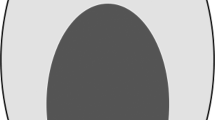Abstract
We consider bistochastic quantum channels generated by unitary representations of a discrete group. We give a proof of the additivity conjecture for a quantum depolarizing channel Φ based on the decreasing property of the relative entropy. We show that the additivity conjecture holds for a channel Ξ = Ψ o Φ, where Ψ is a phase damping channel.
Similar content being viewed by others
References
Holevo, A.S., Quantum Coding Theorems, Uspekhi Mat. Nauk, 1998, vol. 53, no. 6, pp. 193–230 [Russian Math. Surveys (Engl. Transl.), 1998, vol. 53, no. 6, pp. 1295–1331]; LANL e-print quant-ph/9808023.
Amosov, G.G., Holevo, A.S., and Werner, R.F., On the Additivity Conjecture in Quantum Information Theory, Probl. Peredachi Inf., 2000, vol. 36, no. 4, pp. 25–34 [Probl. Inf. Trans. (Engl. Transl.), 2000, vol. 36, no. 4, pp. 305–313]; LANL e-print quant-ph/0003002.
Cortese, J., The Holevo-Schumacher-Westmoreland Channel Capacity for a Class of Qudit Unital Channels, LANL e-print quant-ph/0211093.
Holevo, A.S., Remarks on the Classical Capacity of Quantum Covariant Channels, LANL e-print quant-ph/0212025.
Shor, P.W., Equivalence of Additivity Questions in Quantum Information Theory, Comm. Math. Phys., 2004, vol. 246, no. 3, pp. 453–472; LANL e-print quant-ph/0305035.
Amosov, G.G. and Holevo, A.S., On the Multiplicativity Conjecture for Quantum Channels, Teor. Veroyatn. Primen., 2002, vol. 47, no. 1, pp. 143–146 [Theory Probab. Appl. (Engl. Transl.), 2003, vol. 47, no. 1, pp. 123–126]; LANL e-print quant-ph/0103015.
King, C., Additivity for Unital Qubit Channels, J. Math. Phys., 2002, vol. 43, no. 10, pp. 4641–4653; LANL e-print quant-ph/0103156.
King, C., The Capacity of the Quantum Depolarizing Channel, IEEE Trans. Inform. Theory, 2003, vol. 49, no. 1, pp. 221–229; LANL e-print quant-ph/0204172.
Shor, P.W., Additivity of the Classical Capacity of Entanglement-Breaking Quantum Channels, J. Math. Phys., 2002, vol. 43, no. 9, pp. 4334–4340; LANL e-print quant-ph/0201149.
Fannes, M., Haegeman, B., Mosconyi, M., and Vanpeteghem, D., Additivity of Minimal Entropy Output for a Class of Covariant Channels, LANL e-print quant-ph/0410195.
Datta, N., Holevo, A.S., and Suhov, Yu., Additivity for Transpose Depolarizing Channels, LANL e-print quant-ph/0412034.
Holevo, A.S. and Shirokov, M.E., On Shor’s Channel Extension and Constrained Channels, Comm. Math. Phys., 2004, vol. 249, no. 2, pp. 417–430; LANL e-print quant-ph/0306196.
Werner, R.F. and Holevo, A.S., Counterexample to an Additivity Conjecture for Output Purity of Quantum Channels, J. Math. Phys., 2002, vol. 43, no. 9, pp. 4353–4357; LANL e-print quant-ph/0203003.
Ohya, M. and Petz, D., Quantum Entropy and Its Use, Berlin: Springer, 1993.
Author information
Authors and Affiliations
Additional information
Original Russian Text © G.G. Amosov, 2006, published in Problemy Peredachi Informatsii, 2006, Vol. 42, No. 2, pp. 3–11.
Supported in part by the INTAS, grant no. 00-738.
Rights and permissions
About this article
Cite this article
Amosov, G.G. Remark on the additivity conjecture for a quantum depolarizing channel. Probl Inf Transm 42, 69–76 (2006). https://doi.org/10.1134/S0032946006020013
Received:
Accepted:
Issue Date:
DOI: https://doi.org/10.1134/S0032946006020013




